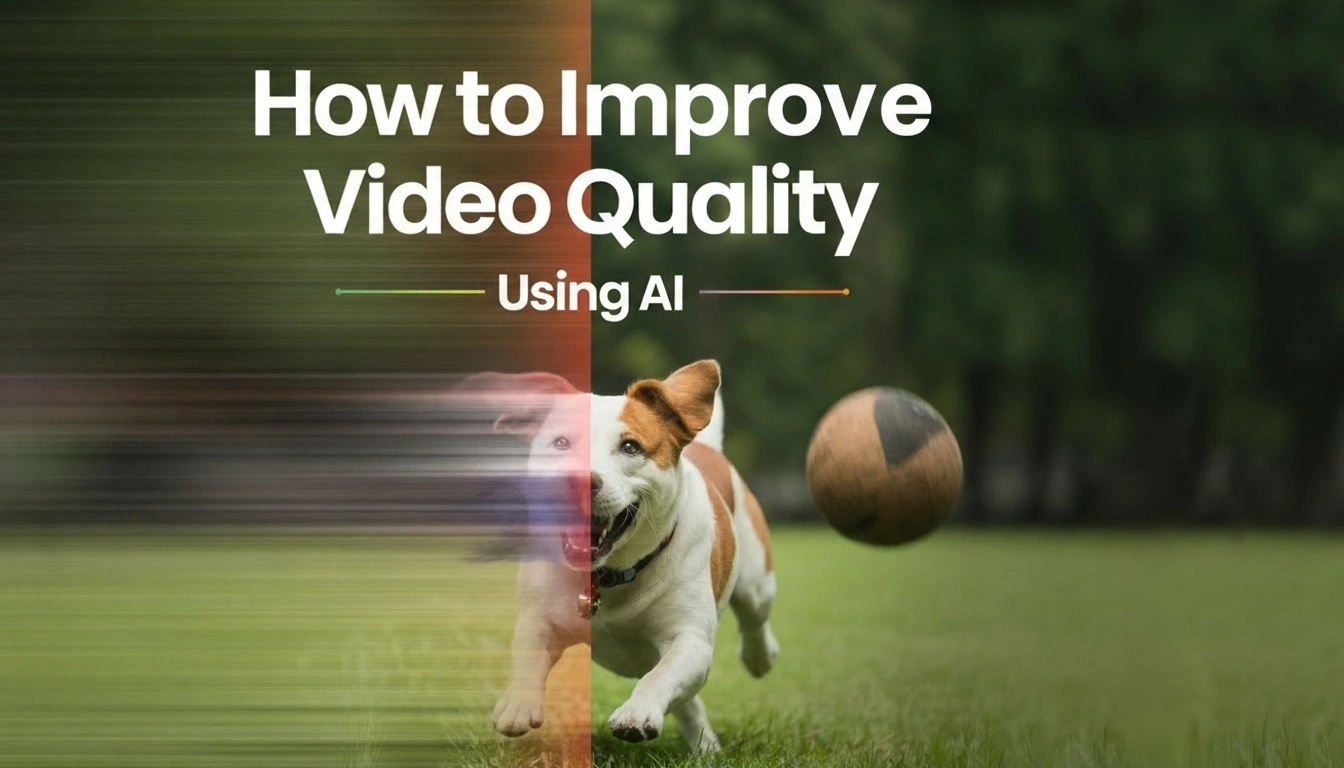

Aqsa Nazir Kayani
Mon Oct 13 2025
6 mins Read
Let’s be honest for a minute: bad video quality can ruin your content. Grainy, shaky footage, or dull colors make videos look unprofessional. ImagineArt AI video enhancer lets you improve the quality of videos quickly using simple text instructions.
Let's get into the blog!
What Is AI Video Enhancement and Why It Matters
AI video enhancement uses machine learning algorithms to automatically improve video quality. Key capabilities include:
- Upscaling Resolution: Predicts missing pixels and increases clarity.
- Noise Reduction: Removes grain, static, and compression artifacts without softening the image.
- Stabilization: Smooths shaky handheld or drone footage.
- Color Correction and Grading: Adjusts brightness, contrast, and color tones.
- Frame Interpolation: Generates new frames to create smooth motion in low-FPS footage.
Why it matters:
- Saves hours of manual editing
- Enhances viewer engagement and retention
- Makes old footage usable for modern platforms
- Ensures consistent visual quality across multiple videos
This is how we write CTA:
Preparing Your Video for AI Edits
Even the best AI performs better when the footage is prepared correctly.
Steps to prepare:
- Backup your original video to prevent accidental loss.
- Trim unnecessary clips so the AI focuses on important segments.
- Check resolution and clarity; extremely blurry footage may limit results.
- Identify the sections to enhance and note timestamps for precise instructions.
Tip: Breaking the video into short segments allows more precise AI control over specific sections.
5 Steps to Use ImagineArt AI Video Quality Enhancer
Step 1: Upload Your Video
Upload your video to ImagineArt AI Video Enhancer. The AI automatically analyzes low resolution, blurry, or compressed videos and prepares them for enhancement, ensuring every frame is optimized for high definition output. How to do it:
- Select your video in MP4 or MOV format.
- Backup the original video before uploading.
Tips for better results:
- Break long videos into smaller segments if possible; this allows the AI to focus and reduces processing time.
- Avoid overly compressed files; high-bitrate formats give AI more visual information to work with.
Step 2: Write Your Edit Instructions
Once your video is uploaded, the key step is instructing the AI what to do. Text clarity and precision are everything here. Poorly worded instructions will produce unpredictable results, while precise prompts make the AI a powerful editing assistant.
How to do it:
- Use specific language to describe what you want.
Here are some examples:
- “Increase sharpness in the first 15 seconds.”
- “Enhance the colors in the sunset and increase warmth.”
- “Smooth out camera shake from 1:00 to 1:30.”
- “Reduce noise in low-light areas without losing detail.”
Tips for better results:
- Include timestamps to target exact sections.
- Break complex edits into multiple prompts rather than one long instruction.
- Use descriptive adjectives for mood/style: “cinematic,” “soft,” “high contrast.”
Step 3: Preview AI Edits
Before committing to the full video, it’s essential to preview a segment. This ensures the AI interpreted your instructions correctly and prevents wasted time on full renders.
How to do it:
- Select a 5–10 second segment of the video.
- Apply your instructions to see how the AI edits the clip.
- Evaluate for over-processing, unnatural textures, or color shifts.
Tips for better results:
- Use split-screen comparison with the original video.
- Adjust your instructions incrementally based on the preview.
- Focus on sections with the most noticeable issues first.
Step 4: Refine Instructions
If the preview isn’t perfect, don’t worry. The AI works best iteratively. Refining your text prompts ensures the final video meets your expectations.
How to do it:
- Edit prompts to be more specific: e.g., “increase red and orange saturation in the sky” instead of “make colors better.”
- Split edits for complex segments: e.g., one instruction for sharpness, another for color, another for stabilization.
- Use reference language: e.g., “match the color grading of a cinematic trailer.”
Tips for better results:
- Keep track of successful prompts for future projects.
- Test different phrasing if your instructions don’t give the desired effect.
- Read about how to write a good prompt to improve your prompt writing.
Step 5: Render and Export
Once the preview and refinements look good, it’s time to generate the full video. Rendering is your final step, where all text instructions are applied across the entire footage.
How to do it:
- Apply the refined instructions to the full video.
- Choose your preferred resolution and output format.
- Render the video and download once complete.
Tips for better results:
- Export a short test segment at full resolution to verify output quality before rendering the entire video.
- Consider saving multiple versions with slight variations for A/B testing.
- Review the final video carefully to ensure edits match your instructions exactly.
Common Mistakes to Avoid When Enhancing Videos
- Vague Instructions: Avoid terms like “make it look nicer.” Be precise.
- Skipping Previews: Always preview before rendering the full video.
- Too Many Instructions at Once: Break complex edits into smaller, manageable instructions.
- Ignoring Timestamps: AI works best when it knows the exact sections to enhance.
- Over-editing: Too many layers of edits can create unnatural results.
Who Can Benefit from ImagineArt AI Video Improver
Here’s how different users can make their videos better, faster, and more professional using ImagineArt Ai video enhancer.
- Content Creators: Polish videos for TikTok, YouTube Shorts, or Instagram. Fix shaky clips, brighten colors, and remove grain without spending hours editing.
- Marketing Teams: Update old campaigns or ad footage. Enhance product videos, improve lighting, and make visuals pop for better engagement.
- Filmmakers & Videographers: Use ImagineArt AI video editor to edit scenes with sharper details, smoother motion, and consistent colors. Save time on tedious manual edits.
- Educators & Trainers: Make instructional videos easier to follow. Highlight key visuals, improve clarity, and reduce distractions from noise or poor lighting.
- Small Businesses & Startups: Upgrade product demos, explainer videos, or social media content quickly. A few text instructions can make your videos look professional, without hiring an editor.
Recommended Read:
Best AI Video Editing Tools for Influencer Marketing
So there you have it!
With the ImagineArt AI video enhancer, anyone can turn ordinary footage into polished, professional videos. Just write clear instructions, preview, refine, and export. Whether you’re a content creator, marketer, teacher, or business owner, better-looking videos are just a few words away. However, if you want high-quality videos that don’t need editing, you can give the ImagineArt AI video generator a try! Don’t wait and start creating perfect videos today!
Frequently Asked Questions
What are the best ways to fix shaky videos with AI editing?
To fix shaky videos, use Imagine.Art to apply stabilization through text prompts like “smooth handheld camera shake from 0:30 to 1:00.” Always preview edits to ensure motion looks natural.
How do I improve video colors and lighting using AI?
Enhance colors and lighting by writing precise instructions, for example: “make sunset colors warmer and more vibrant” or “adjust brightness and contrast for clarity.” The AI applies edits exactly as described.
Can I use AI to remove noise from low-light videos?
Yes. Text-to-edit AI can reduce grain and noise in dark footage. Try instructions like “remove noise from shadows while keeping details sharp.” Preview the changes before full rendering.
What types of videos can benefit from text-to-edit AI enhancements?
Almost any video can benefit, including social media clips, marketing ads, instructional content, product demos, and professional film footage. Clear text instructions are key for the best results.
How do I write effective AI video enhancement prompts?
Be specific, use timestamps, and describe the desired effect clearly. Include terms like “sharpness,” “color vibrancy,” “smooth motion,” or “reduce grain” to guide the AI effectively.

Aqsa Nazir Kayani
Aqsa Nazir Kayani specializes in SaaS and Gen AI, delivering search-optimized content that boosts visibility and strengthens brand authority.